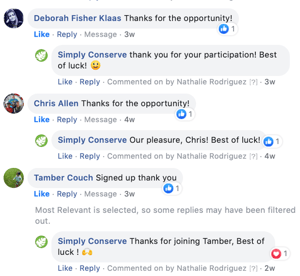Our Innovation Lab team recently asked the question: can sweepstakes help increase email addresses, brand awareness and engagement? To answer the question, we decided to design a sweepstakes project of our own to determine whether it would be an effective way to engage energy efficiency audiences. In part one of this two-part series, we discussed the foundations of building a sweepstakes. Now, it’s time to discuss the benefits and analytics of a sweepstakes campaign.
Get caught up! Read Part 1 of this blog here.
The Benefits
As predicted, the benefits of running a sweepstakes were many and varied. This also proved to be a very cost-effective campaign, coming in at a total of less than $500 spent. Below, we outline the 3 primary benefits identified.
1. Brand Awareness & Increased Engagement
Since sweepstakes typically offer a high-value incentive and require at least some participants to win, engagement should be expected. And since they’re promoted and available to anyone eligible, they naturally spread brand awareness. Gaining brand awareness and engagement was our project’s secondary goal, and it was successfully achieved through digital marketing tactics.
 Our paid and organic Facebook posts promoting the sweepstakes reached 61,847 percent more people than our organic posts regarding other topics. This trend was also seen on Twitter, where we saw an increase of 586.4 percent, and on Pinterest, where we saw an increase of 561 percent.
Our paid and organic Facebook posts promoting the sweepstakes reached 61,847 percent more people than our organic posts regarding other topics. This trend was also seen on Twitter, where we saw an increase of 586.4 percent, and on Pinterest, where we saw an increase of 561 percent.
Engagement was seen from both our existing audience and new prospects that were gained through both paid and earned media. Engagement included likes, shares, and comments. On Facebook, we saw engagement increase by 100 percent, and on Pinterest, engagement increased by 151 percent. Followers also grew across all our social channels, with the highest growth coming from Pinterest, which increased by 97 percent. Interestingly, social media post likes, comments and shares were not required to enter the sweepstakes, yet these actions were consistently taken throughout the test period.
 Our email open rates and click-to-open rates were above our benchmarks for select emails in the four-email series (e.g., lead generation, two remarketing, last call). We saw a high of 40 percent above benchmark for the initial lead generation email open rate and a high of 360 percent above benchmark for the second remarketing email’s click-to-open rate. Since these emails were sent from our test lab site that only receives marketing when we’re running innovation project tests, we anticipate better overall results when consistent marketing is taking place for an established online store. In general, engagement with these emails was not quite as high as coupon or other promotional emails, but it was higher than what we see with regular outreach emails.
Our email open rates and click-to-open rates were above our benchmarks for select emails in the four-email series (e.g., lead generation, two remarketing, last call). We saw a high of 40 percent above benchmark for the initial lead generation email open rate and a high of 360 percent above benchmark for the second remarketing email’s click-to-open rate. Since these emails were sent from our test lab site that only receives marketing when we’re running innovation project tests, we anticipate better overall results when consistent marketing is taking place for an established online store. In general, engagement with these emails was not quite as high as coupon or other promotional emails, but it was higher than what we see with regular outreach emails.
2. New Leads & Audience Data
Thoughtful sweepstakes design is important when it comes to gathering valuable audience data. This data can vary from essentials such as names, emails, and addresses to more targeted insights such as preferences, habits, and needs. These audience insights can be used to grow your marketing list and generate new leads, as well as create a better marketing experience for your audience in future campaigns.
3. Brand Trust
Sweepstakes can do more than generate leads; they can also help improve trust in your brand. Ultimately, sweepstakes are seen as rewards, which serve as positive reinforcers from you to your audience. The optics of you giving away rewards paints your brand as generous, trusting, and likable. Through our innovation project, there was a high number of tracked positive reactions, including comments of gratitude from the audience for hosting the sweepstakes and providing them an opportunity to participate, as well as compliments to the brand itself.
Conclusion
Hosting a sweepstakes is an innovative tactic that can help your team obtain opt-in email addresses while improving brand awareness and deepening engagement. In addition, if strategically designed, you can gain insightful audience data that you can use to make an even more successful sweepstakes in the future, as well as tailor other campaigns to best match your target audience.
This innovation project lasted just 14 days and had a budget of less than $500, yet we were able to gain thousands of valid, tracked, completed actions aligned with our primary and secondary goals, as well as more than 1,000 new opt-in email addresses and hundreds of customers who signed up for our rewards program, which will permit even deeper engagement over time. Although this innovation project focused on residential customers, we have already outlined a strategy whereby this could work for small commercial customers. The key element of that strategy is to employ additional micro-targeting tactics.






